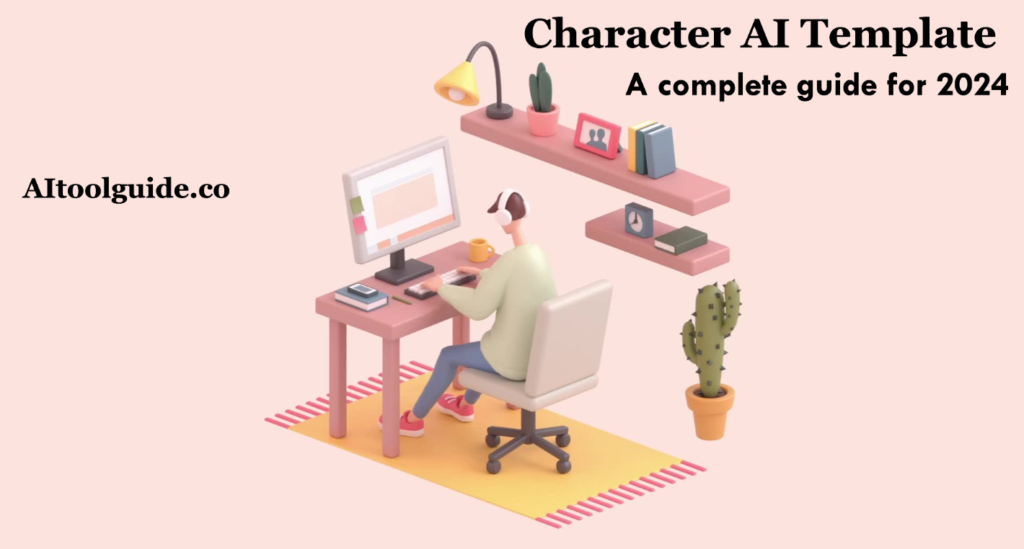Character AI templates are powerful tools that provide a structured approach to character creation, enabling developers to craft detailed and dynamic characters with ease.
These templates simplify the process by offering predefined fields for attributes such as demographics, physical appearances, psychological traits, and relationships.
The use of Character AI templates helps developers save time, ensure uniformity, and create characters that engage users.
As a result, this structured approach simplifies the character development process but also makes AI-driven interactions more engaging. Continue reading to learn more about Character AI.
What is a Character AI Template?
A Character AI template is a structured framework used to create detailed and dynamic characters for various AI applications, such as chatbots, virtual assistants, and interactive media.
These templates serve the purpose of streamlining the character creation process by providing predefined fields for essential character attributes, ensuring consistency and depth in character development.
Key components of a Character AI template typically include demographics (name, age, gender, occupation), physical appearance (eye color, hair color, height), psychological traits (personality type, temperament, hobbies), and relationships (family, friends, rivals).
Additionally, they encompass backstory and motivations, which are crucial for crafting rich, engaging narratives that drive characters’ actions and decisions.
By utilizing these templates, developers can efficiently create well-rounded characters that enhance user engagement and interaction, offering a more immersive and personalized experience.
Benefits of Using Character AI Templates
Character AI templates offer a multitude of benefits, making them invaluable tools for developers and content creators. One of the primary advantages is the streamlined character-creation process.
These templates simplify the process of developing detailed and consistent characters by providing predefined fields for various attributes.
This allows creators to focus more on the creative aspects of character development rather than getting bogged down in the minutiae of data entry.
Another significant benefit is the enhanced consistency and accuracy in character traits.
Character AI templates ensure that all necessary details are captured uniformly across different characters, which is crucial for maintaining character integrity and coherence, especially in complex narratives or interactive applications.
This uniformity helps in creating believable and relatable characters that can engage users more effectively.
Additionally, improved user engagement and interaction is a key advantage of using Character AI templates.
Well-crafted characters with rich backstories and defined traits can interact more naturally and meaningfully with users, providing a more immersive and engaging experience.
This is particularly beneficial in applications like virtual assistants, customer service bots, and interactive storytelling, where user interaction is paramount.
Lastly, Character AI templates offer flexibility in customizing characters for various needs. Whether you need a heroic protagonist, a cunning antagonist, or a quirky sidekick, these templates can be easily tailored to fit specific roles and contexts.
This adaptability makes them suitable for a wide range of applications, from gaming and entertainment to educational tools and business solutions.
By leveraging the flexibility of Character AI templates, developers can create unique and memorable characters that enhance the overall user experience.
Key Elements of a Character AI Template
A comprehensive Character AI template includes several key elements that collectively contribute to the creation of well-rounded and engaging characters.
Demographics form the foundational layer, including basic but essential details such as the character’s name, age, gender, ethnicity, and occupation. These attributes help in establishing the character’s identity and context within the narrative.
Physical appearance is another critical component, detailing aspects like eye color, hair color, height, weight, and distinguishing features. These elements are crucial for visual representation and help users visualize the character more vividly.
The history section discusses the character’s past, including their birthdate, place of birth, key family members, and notable events that have shaped their life. This background information provides depth and context, making the character more relatable and realistic.
Psychological traits cover the character’s personality type, temperament, hobbies, skills, and fears. These attributes are vital for defining how the character thinks, feels, and behaves, adding layers to their persona.
Communication details the languages known by the character, their preferred methods of communication, and any specific accent they might have. This information is essential for interactions, especially in applications involving dialogue and user engagement.
Strengths and weaknesses outline the character’s physical and intellectual capabilities and limitations. This balance is crucial for creating believable characters who have both vulnerabilities and strengths, making them more human-like.
Relationships map out the character’s connections with others, including family, friends, rivals, and mentors. These relationships are integral to the character’s development and interactions within the story or application.
Finally, character growth focuses on the character arc, detailing their goals, motivations, and conflicts. This element is essential for dynamic storytelling, showcasing how the character evolves over time and what drives their actions.
Together, these key elements of a Character AI template ensure the creation of rich, multidimensional characters that can engage users effectively across various AI applications.
How to Create a Character AI Template?
Creating a Character AI template involves a structured approach to ensure that your characters are detailed, consistent, and engaging.
Here’s a step-by-step guide to building a comprehensive character template, along with tips for customization and examples of well-structured templates.
1. Choose the Right Template:
- Begin by selecting a template that aligns with the vision of your character. Templates can vary based on genre, setting, and complexity.
- Evaluate predefined options and review customization features to ensure the template meets your needs.
2. Fill Out Basic Information:
Start with the character’s demographics: name, age, gender, ethnicity, and occupation. This forms the foundation of your character’s identity.
3. Define Physical Appearance:
Specify details such as eye color, hair color, height, weight, and any distinguishing features. This helps in visualizing the character more vividly.
4. Craft the Backstory:
Include the character’s birthdate, place of birth, key family members, and notable events. A compelling backstory adds depth and context to the character.
5. Outline Psychological Traits:
Describe the character’s personality type, temperament, hobbies, skills, and fears. These traits are crucial for defining how the character thinks, feels, and behaves.
6. Detail Communication Preferences:
Note the languages known, preferred communication methods, and any specific accents. This is essential for interactions, especially in dialogue-driven applications.
7. Identify Strengths and Weaknesses:
Outline the character’s physical and intellectual strengths and weaknesses. This balance makes the character more realistic and relatable.
8. Map Relationships:
Define the character’s connections with family, friends, rivals, and mentors. Relationships are vital for character development and interactions within the story.
9. Plan Character Growth:
Detail the character arc, including goals, motivations, and conflicts. This showcases how the character evolves over time and what drives their actions.
Tips for Customizing Templates to Suit Specific Character Needs
Adapt to Genre and Setting:
Customize the template based on the genre (e.g., fantasy, sci-fi) and the setting (e.g., medieval, futuristic) to ensure relevance.
Use Thought-Provoking Prompts:
Fill in prompts that uncover formative events and experiences, adding depth and authenticity to the character.
Iterate and Refine:
Continuously update and refine the character template as the story or application evolves to maintain consistency and engagement.
Examples of Well-Structured Character Templates
Example 1:
text
{{char}}=
description= {
Name: “John Doe”,
Alias: “The Wanderer”,
Age: “35”,
Gender: “Male”,
Personality: “Stoic, Resourceful, Loyal”,
Backstory: “Born in a small village, John lost his family to a war and has been wandering ever since, seeking purpose.”,
Relationships: “Mentor: Old Man Jenkins, Rival: The Dark Knight”,
Traits: “Excellent survival skills, proficient in hand-to-hand combat”,
Motivations: “To find a place he can call home”,
Dialogue: “I’ve seen more than my share of battles. What’s your story?”
}
Example 2:
text
{{char}}=
description= {
Name: “Luna Star”,
Alias: “The Enchantress”,
Age: “28”,
Gender: “Female”,
Personality: “Mysterious, Charismatic, Intelligent”,
Backstory: “Luna was raised by a coven of witches and has always been drawn to the arcane arts.”,
Relationships: “Friend: Elara the Healer, Enemy: The Shadow King”,
Traits: “Master of illusion, skilled in potion-making”,
Motivations: “To uncover the secrets of her past”,
Dialogue: “Magic is not just a tool; it’s a part of who I am.”
}
By following these steps and tips, and using well-structured examples as a guide, you can create detailed and engaging characters that enhance user interaction and experience in AI applications.
Popular Character AI Template Resources
Character AI templates are essential tools for developers and content creators, providing a structured framework for creating engaging and lifelike characters.
Here’s an overview of some of the top platforms offering these templates, along with a comparison of their features and community feedback.
1. Scribd:
Features: Known for its vast library of documents, Scribd also offers character templates that can be used for AI development. These templates are detailed and cater to different storytelling needs.
Usability: Easy to navigate with a comprehensive search function to find specific templates. Users can also upload and share their own templates.
2. Wattpad:
Features: Primarily a storytelling platform, Wattpad provides character templates that are particularly useful for writers and developers looking to create rich narratives. The templates include fields for detailed character descriptions and backstories.
Usability: The platform is designed for writers, making it very user-friendly. It also has a strong community where users can share feedback and collaborate.
Comparison of Features and Usability
| Platform | Features | Usability |
| Character.AI | Customizable attributes, dynamic interactions, extensive documentation | Highly intuitive, strong community |
| Scribd | Vast library of templates, easy search and upload functions | User-friendly, comprehensive |
| Wattpad | Detailed templates for storytelling, strong focus on narrative elements | Writer-focused, collaborative |
Community Feedback and Reviews
Character.AI: Users appreciate the platform’s ease of use and the depth of customization available. It has received positive reviews for its ability to create lifelike characters and dynamic interactions.
Scribd: The platform is praised for its extensive library and the ability to find specific templates easily. Users also value the option to share and collaborate on templates.
Wattpad: Known for its strong community of writers, Wattpad receives high marks for its detailed templates and the collaborative environment it fosters. Users find it particularly useful for narrative development.
The use of these platforms enables developers and writers to efficiently create detailed characters that enhance user interaction and storytelling.
Case Studies and Examples of Character AI Implementations
Character AI templates have been successfully implemented across various industries, showcasing their versatility and effectiveness. Here are some real-world examples, analyses, and lessons learned from these implementations.
Real-World Examples of Successful Character AI Implementations
1. Sephora’s Virtual Assistant:
Sephora uses a virtual assistant powered by Character AI to provide personalized beauty advice and product recommendations. The AI assistant has significantly enhanced customer engagement and satisfaction, leading to increased sales and customer loyalty.
2. HDFC Bank’s AI Chatbot:
HDFC Bank deployed an AI chatbot to handle customer inquiries and provide real-time support. The chatbot has improved operational efficiency by reducing the workload on human agents and providing 24/7 customer service, resulting in a 30% reduction in customer service costs.
Conclusion
Using character AI templates, developers can create virtual characters in a structured way, enhancing both user experience and engagement.
With these templates, you can create realistic and interactive characters that can be used in storytelling, gaming, customer service, and education, among other applications.
You can save time, improve consistency, and customize characters to fit your needs with Character AI templates.
As AI technology continues to advance, we can expect more sophisticated and lifelike characters to engage users in meaningful ways in the future.
This evolution will likely lead to new opportunities for innovation in digital content creation and user interaction.
- Guide to Connect Claude AI with Google Sheets in 2024 - October 11, 2024
- What is DreamGF? Honest review by Expert - October 9, 2024
- How to Use Claude AI in 2024? - October 7, 2024






